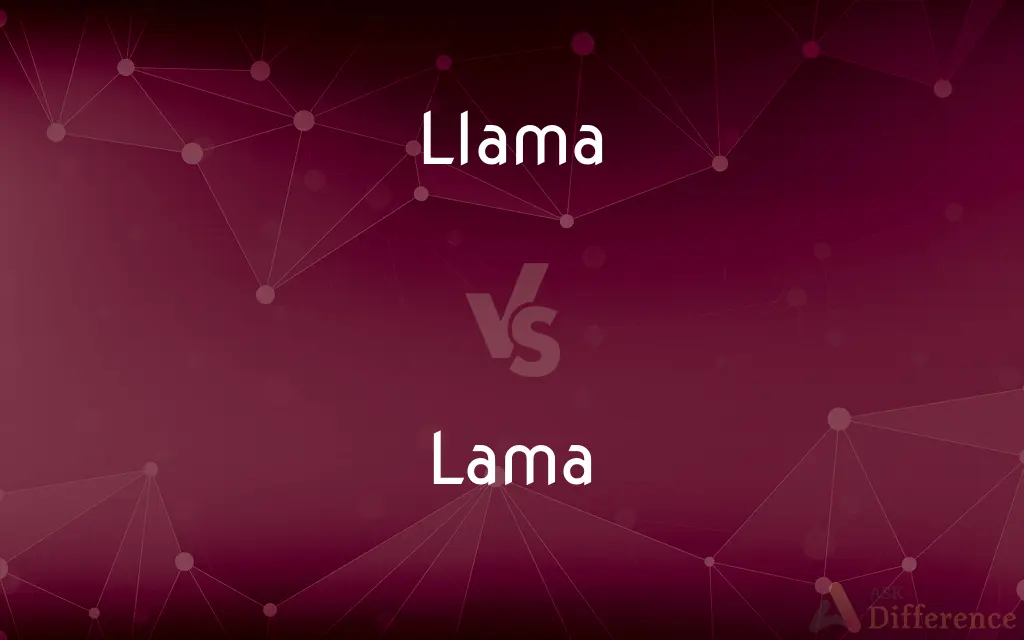Llama vs. Lama — What's the Difference?
By Tayyaba Rehman & Maham Liaqat — Updated on March 7, 2024
Llama refers to a South American camelid, known for its wool, while Lama signifies a Tibetan Buddhist spiritual teacher.

Difference Between Llama and Lama
Table of Contents
ADVERTISEMENT
Key Differences
Llamas are domesticated pack animals native to the Andean highlands of South America, valued for their wool, meat, and as pack animals. On the other hand, Lama refers to a title for a teacher or mentor in Tibetan Buddhism, denoting a spiritual leader who is respected for their wisdom and teachings.
Llamas are social animals, living in herds and known for their gentle and curious nature. They play a significant role in traditional Andean culture, used not only for their physical resources but also in various cultural and spiritual practices. Dalai Lama and Panchen Lama are among the most recognized titles within this tradition, each holding immense religious and historical significance in Tibetan Buddhism.
While llamas are involved in the physical aspects of Andean societies, providing resources and labor, Lamas play a pivotal role in the spiritual and religious life of Tibetan communities. This distinction highlights the differing realms in which these terms operate—one in the physical and cultural landscape of South America and the other in the spiritual and religious sphere of Tibetan Buddhism.
Both llamas and Lamas hold significant cultural importance within their respective contexts. However, their roles and the attributes associated with them diverge greatly, reflecting the diverse ways in which animals and spiritual leaders are woven into the social and cultural fabric of societies. This contrast underscores the varied meanings and significance attributed to similar-sounding terms across different cultures and traditions.
Comparison Chart
Definition
A domesticated South American camelid
A title for a Tibetan Buddhist teacher
ADVERTISEMENT
Origin
Andean regions of South America
Tibetan Buddhism
Primary Role
Wool production, meat, and use as pack animals
Spiritual guidance and teaching
Significance
Cultural and economic importance in Andean societies
Religious and spiritual leadership in Tibetan Buddhism
Physical Traits
Long neck, elongated face, thick fur
Human; the term refers to spiritual stature, not physical traits
Compare with Definitions
Llama
A mammal native to South America, used for wool and as a pack animal.
The llama grazed peacefully on the highland grass.
Lama
A title of respect for a Buddhist monk or nun.
The lama was revered by the community for his teachings.
Llama
Lives in herds and feeds on grass.
A herd of llamas can often be seen grazing together.
Lama
A spiritual leader within Tibetan Buddhism.
The lama led the monastery with great wisdom.
Llama
Employed to carry goods across difficult terrain.
They loaded the llamas with supplies for the mountain journey.
Lama
Known for profound understanding of Buddhist philosophy.
The lama's teachings on compassion touched many hearts.
Llama
Indigenous to the Andean mountains.
Llamas have been integral to Andean cultures for centuries.
Lama
Guides students in their religious practices.
As her lama, he provided insightful guidance on meditation.
Llama
Known for its thick, soft wool used in textiles.
Llama wool is prized for its warmth and softness.
Lama
Offers guidance on Buddhist teachings and practices.
He sought the lama's advice on his spiritual journey.
Llama
The llama (; Spanish pronunciation: [ˈʎama]) (Lama glama) is a domesticated South American camelid, widely used as a meat and pack animal by Andean cultures since the Pre-Columbian era. Llamas are very social animals and live with others as a herd.
Lama
Lama (Tibetan: བླ་མ་, Wylie: bla-ma; "chief" ) is a title for a teacher of the Dharma in Tibetan Buddhism. The name is similar to the Sanskrit term guru, meaning "heavy one", endowed with qualities the student will eventually embody.
Llama
A domesticated pack animal of the camel family found in the Andes, valued for its soft woolly fleece.
Lama
An honorific title applied to a spiritual leader in Tibetan Buddhism, whether a reincarnate lama or one who has earned the title in life.
Llama
A domesticated South American ruminant mammal (Lama glama) related to the camel and having a long neck and small head, raised for its warm wool and used as a beast of burden.
Lama
A Tibetan or Mongolian Buddhist monk.
Llama
Any of various related mammals, such as the alpaca and the guanaco.
Lama
In Tibetan Buddhism, one who is a religious teacher or is in a position of authority in a monastic community.
Llama
A South American mammal of the camel family, Lama glama, used as a domestic beast of burden and a source of wool and meat.
Lama
A master of Tibetan Buddhism.
Llama
Archaic form of lama
Lama
See Llama.
Llama
A South American ruminant (Auchenia llama), allied to the camels, but much smaller and without a hump. It is supposed to be a domesticated variety of the guanaco. It was formerly much used as a beast of burden in the Andes, and is also kept on some ranches in the United States.
Lama
In Tibet, Mongolia, etc., a priest or monk of the belief called Lamaism.
Llama
The fleece of the llama{1}, a fine, soft wool-like hair.
Lama
A Tibetan or Mongolian priest of Lamaism
Llama
Wild or domesticated South American cud-chewing animal related to camels but smaller and lacking a hump
Lama
Llamas
Common Curiosities
What's the significance of the Dalai Lama?
The Dalai Lama is the spiritual leader of Tibetan Buddhism, believed to be the reincarnation of a long line of spiritual leaders.
Do llamas spit?
Yes, llamas can spit as a defense mechanism or to assert dominance within their herd.
Can llamas be kept as pets?
While llamas are primarily livestock, they can be kept as pets under appropriate conditions.
Are llamas and alpacas the same?
No, llamas and alpacas are distinct species with different physical and behavioral traits.
How are llamas used in Andean cultures today?
Llamas continue to be used for their wool, meat, and as pack animals in modern Andean societies.
Is Lamaism another term for Tibetan Buddhism?
Lamaism is an outdated term for Tibetan Buddhism, focusing on the role of Lamas in the religion.
How does one become a Lama?
Becoming a Lama requires rigorous religious study, meditation, and practice within the Tibetan Buddhist tradition.
How do Lamas contribute to their communities?
Lamas provide spiritual leadership, teach Buddhist principles, and offer guidance to their followers.
Can anyone become a Lama in Tibetan Buddhism?
Becoming a Lama involves years of study and spiritual practice under the guidance of mentors.
Are all Lamas reincarnated beings?
Not all Lamas are considered reincarnations; some earn the title through study and spiritual practice.
What role do Lamas play in Tibetan Buddhism?
Lamas play a central role in teaching, guiding spiritual practices, and leading religious communities.
How important is the Lama to Tibetan culture?
The Lama holds immense cultural and spiritual importance in Tibetan society, embodying Buddhist values and leadership.
What do llamas eat?
Llamas are herbivores, primarily grazing on grass.
What's the difference between a Lama and a monk?
A Lama is a teacher or spiritual leader in Tibetan Buddhism, while a monk is a member of the monastic community.
Can llamas live in lowland areas?
While adaptable, llamas thrive in high-altitude environments similar to their Andean homeland.
Share Your Discovery

Previous Comparison
Signature vs. Moniker
Next Comparison
Thermometer vs. PyrometerAuthor Spotlight
Written by
Tayyaba RehmanTayyaba Rehman is a distinguished writer, currently serving as a primary contributor to askdifference.com. As a researcher in semantics and etymology, Tayyaba's passion for the complexity of languages and their distinctions has found a perfect home on the platform. Tayyaba delves into the intricacies of language, distinguishing between commonly confused words and phrases, thereby providing clarity for readers worldwide.
Co-written by
Maham Liaqat













































